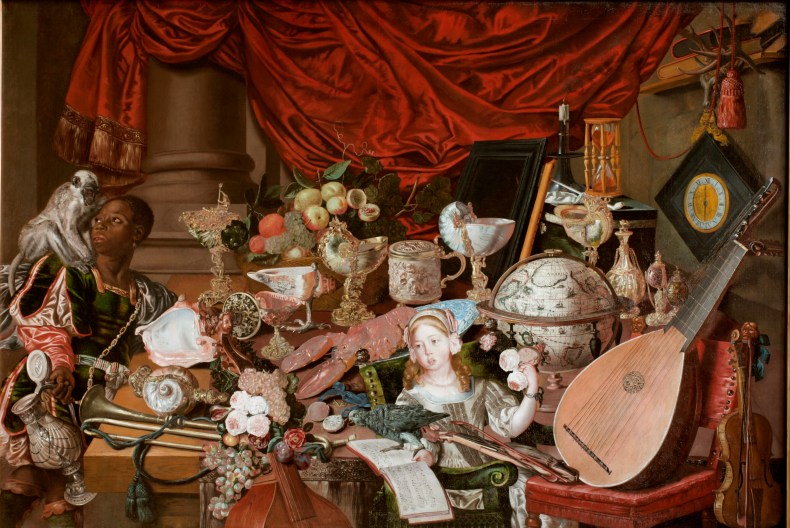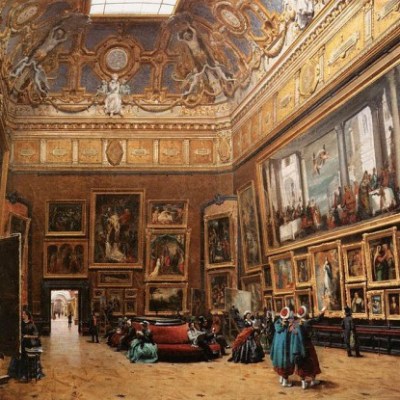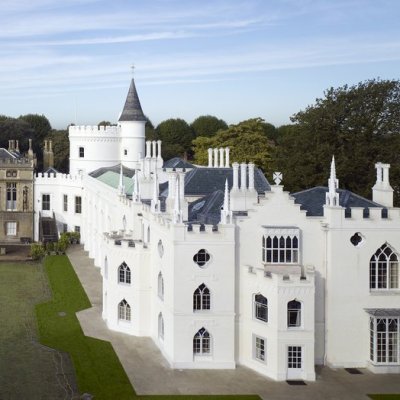Whether in national galleries, royal academies or country houses, reconstructions enjoy today a remarkable vogue, emerging as among the most striking and ambitious types of exhibition staged in recent years.
In essence, these shows all seek to reverse the passage of time and reconstitute a lost collection. They are the product of influences at once intellectual, financial and political. Tracking down and reassembling the lost objects from a collection is an exhausting business, one that is forever incomplete. It demands co-operation across national borders and the cultivation of institutional partnerships. Securing the trust and generosity of the Hermitage, for instance, was essential for Robert Walpole’s gallery to return to Houghton in 2013. ‘The Paston Treasure’ at Norwich Castle last year was a local story about a 17th-century family whose ambition and mismanagement led to the dismantling of their spectacular collections and their home, Oxnead Hall. But reuniting some of the original objects – including silver-gilt flagons and nautilus cups – with an enigmatic painting of c. 1665 in which they were depicted required the assistance of organisations much further afield: loans from the Met, the Art Institute of Chicago and the Rijksmuseum joined the expertise of the Paul Mellon Centre.
Beyond the practical limitations are a host of intellectual challenges. Collections are dynamic entities and opting to go back to just one phase in their evolution necessarily excludes others. At what stage of its life is a collection ‘complete’? Is it when the collection is at its largest? When it is officially documented or recorded in catalogues, or captured in paint or in photographs? When its creator dies? Or when it is about to be dispersed? If the latter, how should the nature of its ending be integrated into the presentation? In the case of ‘Charles I: King and Collector’ at the Royal Academy in 2018, the brutal demise of the collection was largely absent from the narrative, despite its undeniable centrality to the exhibition’s emotive appeal. This depoliticised the display, turning it into a parade of Old Masters and a celebration of princely taste, to be considered quite apart from more volatile contexts.
The Paston Treasure (c. 1633), unknown artist (Dutch school). Norwich Castle Museum & Art Gallery, Norwich. Courtesy Norfolk Museums Service

At their laziest, reconstructive exhibitions can reproduce some of the unhelpful tendencies within the study of collecting more broadly: an obsession with individual biography, invariably told in admiring fashion; a focus on prestigious loans at the expense of minor genres; a general lack of critical perspective. So much effort seems to have been spent, in some shows, on working out how to put these shows together that the rationale for why this is being done can get lost. Of course it is a thrill for art lovers to see famous paintings reassembled in the same space and to imagine the sacra conversazione between them. But beyond the visual rush, how does it advance scholarship, or even public understanding? In some instances, the depressingly slim final catalogues suggest a mismatch between the diplomatic and logistical triumph represented by a gathering of objects and the meagre intellectual returns.
In The Ephemeral Museum, published posthumously in 2000, Francis Haskell regretted the circulation of Old Masters to feed a growing appetite for blockbuster exhibitions. Acknowledging his own delight as a visitor at seeing masterpieces hung together, he warned of the considerable risks posed to paintings as a result of this global traffic, and pleaded that some ‘sense of responsibility for the irreparable and the precious should be restored’. Nearly two decades on, Haskell’s reservations have lost none of their force.
There is also a considerable difference between presenting works in a context in which they originally appeared – often illuminating the relationship between art and architecture – and the installation of works in an entirely new environment. This winter, for example, some 40 canvases that once hung in the Palais Royal went on display at the New Orleans Museum of Art. It is not, however, quite clear what the New Orleans setting added to appreciation of the legendary Orléans collection, which has no connection with Louisiana, beyond a canny piece of marketing for the city’s tricentennial celebrations.
But to what extent does the exhibition venue matter? Many collections have been made homeless by the passage of time, or their original surroundings have been altered beyond recognition. Without Whitehall Palace, what counts today as an authentic reconstruction of Charles I’s pictures? Placing a collection in an entirely new exhibition space requires a certain suspension of disbelief on behalf of museum visitors; by contrast, when the original space is available, the danger resides in insinuating that a single short-lived, often composite arrangement represents the definitive configuration. There must surely be curators who have contended with a sense of public (and personal?) disappointment when the loans are packed away and business returns to normal.
Happily, two imaginative recent exhibitions on either side of the Channel are a reminder of how much can be gained from the ‘reconstructive’ turn. Their scope was rather different: while ‘Lost Treasures of Strawberry Hill’ offered an unrivalled chance to encounter Horace Walpole’s collection at home, ‘A Dream of Italy’ at the Louvre resurrected past modes of classification and display. Both represent remarkable feats of research. The former restored some 200 of the original 4,000 objects to Twickenham’s atmospheric folly, and by offering a sample from the full breadth of his treasures, corrected long-held misunderstandings about Walpole’s tastes. His reputation as a ‘Goth’ pales next to the evidence of his enduring fascination with Graeco-Roman antiquity. Despite his love for ‘everything that is singular’, Walpole inserted his historical curios into a wider investigation into the progress of civilisation and the progress of style. The magnificent Roman stone eagle he bought during his Grand Tour from Cardinal Albani remained his prize possession: so much so that a print of it appeared in his portrait (c. 1756–57) by Joshua Reynolds.
View of the Gallery at Strawberry Hill House, Twickenham, during the ‘Lost Treasures of Strawberry Hill’ exhibition, October 2018. Photo: Kilian O’Sullivan; Courtesy of Norfolk Museums Service

In the same way, Walpole’s well-known interest in English history, as demonstrated by the Holbein Chamber filled with copies of Tudor portraits (alongside Henry VIII’s dagger and Cardinal Wolsey’s hat), should be balanced against his immersion in the cultural history of continental Europe. The French court received near equal billing with England in Walpole’s collections; one of the most imposing loans in the exhibition was a remarkable full-length group portrait of Catherine de Medici and her sons, attributed to the studio of François Clouet. Furthermore, examples of European decorative arts abounded, including Limoges enamels, Urbino maiolica and Sèvres porcelain. Walpole emerged as a figure of European interests and stature, his writings admired and translated by connoisseurs like Mariette, the Comte de Caylus and Séroux d’Agincourt. As Silvia Davoli explains in the catalogue, Walpole’s attraction to smaller items like coins, gems and intaglios arose from their susceptibility to comparative analysis and exchange with his collector peers on the continent. The great eccentric of popular memory was a proud member of the 18th-century republic of letters. Nor was he a lone pioneer; his relationship with the antiquarian George Vertue fundamentally shaped the development of his writings on art and his passion for English history.
Beyond providing insight into the mind of the collector, successful reconstructions can also shed light on the visual habits of past audiences (what the art historian Pascal Griener has called l’histoire du regard). This approach explains the brilliance of ‘A Dream of Italy’, which recomposed the encyclopaedic collections of Giampietro Campana in the Louvre. There is no hyperbole when the organisers claim that Campana created ‘the most important European private collection in the nineteenth century’: it spanned two millennia and ran to more than 12,000 objects. His motivations were partly political: a friend of the Risorgimento, Campana exposed the untold history of artistic creativity on the Italian peninsula, from the glorious days of antiquity to the unredeemed present. He had acquired his fortune through property investments and running the Monte di Pietà banks within the Papal states. Already over-stretched by his feverish pace of acquisition, Campana was arrested for financial improprieties in 1857, put on trial, and condemned to exile. The dispersal of his collections – famed all over Europe, and the subject of pioneering photographs – was hotly contested.
The international team of curators opted to reproduce the taxonomy deployed by Campana himself. He had ordered his ensemble into 12 divisions – eight parts ancient, and four parts modern – with each division devoted to a different type of material. Any recreation of the effect is bound to be subtly subversive; unusually for a show at the Louvre, painting was deferred to the eighth and ninth divisions and was by no means the centrepiece (despite featuring masterpieces by Uccello, Botticelli, Signorelli and portraits from the studiolo of Federico Gonzaga). Despite his interest in the Italian Primitives – many acquired from the sale of Cardinal Fesch’s collection – ancient archaeology was at the core of Campana’s activities. The spectacular fruit of his excavations at Etruscan sites in the 1830s and ’40s, and purchases through the Roman and Neapolitan market, were arrayed at the Louvre in imposing series, showing off the properties of different materials. The iridescence of ancient glass; the lustrous black finish on bucchero vases; the speckled warmth of the terracotta reliefs: all were sources of undimmed visual pleasure. In an era of pared-back, white-cube curation, the density and massing of artefacts felt excitingly transgressive. Nineteenth-century collectors like Campana fretted constantly about the ‘harmony’ between their things, and the syntax of the display in Paris successfully drew out these tonal transitions.
What was staged in Paris, then, was not just one amateur’s obsessions, but a mid 19th-century matrix of civilisations. Campana’s commitment to putting things in series, to thinking about techniques and materials, upending aesthetic hierarchies, and celebrating anonymous and everyday objects would become the norm for many museums by the end of the century. It created a style of curating that today can feel exacting, marshalling a huge volume of erudition and requiring reserves of stamina from the visitor. At the Louvre, energy levels may have flagged by the time the exceptional collection of Renaissance sculptures and ceramics came around, no matter how dazzling the Deruta or how delicate the Della Robbia pieces. Although it was a feast for scholars, one wonders if the show has been a box-office hit.
View of the terracotta collection in the Campana museum at the Monte di Pietà in Rome, published in ‘Antiche opera in plastica’ by Giampetro Campana in 1851. Biblioteca Universitaria di Napoli. © Biblioteca Universitaria di Napoli/Ministero dei Beni et delle Attività Culturali e del Turismo

‘A Dream of Italy’ fits in with a wider trend in the 21st century for exhibitions addressing institutional history. From William Hunter in Glasgow and Joséphine Bowes in Barnard Castle to Richard Wallace in Manchester Square, several founders of museum collections in Britain were the subject of anniversary exhibitions last year. After a run of impressive shows on Alexandre Lenoir, Dominique-Vivant Denon, Louis La Caze and Campana, the Louvre will mark 2019 with an exhibition devoted to the prints and drawings connoisseur Horace His de la Salle. It is tempting to wonder if the growing importance of private and corporate philanthropy in the museum sector has encouraged a focus on donors new and old. And, at a time of budgetary constraints, such exhibitions are comparatively cheap to put on, as many of the pieces can be sourced internally. ‘Painters’ Paintings’ at the National Gallery in 2016, for instance, grouped artworks in relation to their previous owners to create a stimulating new lens through which to see the permanent collection.
More explicitly political factors can be seen in the way some museums are reckoning with their earlier incarnations. The Victoria and Albert Museum is currently engaged in a huge project to renovate the South Court galleries, a project that will not just resurrect the 19th-century aesthetics of the ‘Kensington Valhalla’, but also spotlight the museum’s place in a web of global and imperial connections. In Belgium, the Africa Museum at Tervuren reopened at the end of last year, its curators seeking to preserve the physical fabric of Leopold II’s monument as it appeared in 1897, while decisively rejecting and reinterpreting its original message. And as modernism recedes into distant memory its most significant moments have also been re-enacted, as in ‘The Armory Show at 100’ at the New York Historical Society in 2013, or the 1937 Degenerate Art exhibition, 80 years on, at the Haus der Kunst in Munich and the Kunstpalast Düsseldorf. In the case of the latter, since the original artworks had been eradicated by the Nazi purge of public museums or forced sales before or during the Second World War, added weight came from the reliance on archival records to compensate for an absent or lost collection.
Reconstructive exhibitions still have a lot to teach us. To be worth all the effort it takes to put them on, they require and can produce exciting new research, in which provenance is both an investigative tool and a topic under investigation. They underline that making a collection is the work of many hands, both in the lifetime of their owners and afterwards. If the modes of display are imaginative enough, they can help us see artworks differently. For Campana, there is a sense in which all the artworks aspired to the condition of sculpture: not just regarding the skills and techniques needed to manipulate matter into its myriad forms over the centuries, but in the curatorial art of grouping objects into phalanxes or pyramidal formations.
Such shows also help demystify collecting for the public, exposing changing attributions and the evidence of dubious restoration practices (especially so in the case of Campana). The danger, however, lies in fetishising any single form of the collection as definitive, condemning everything that comes afterwards as part of a history of irremediable loss. To do so is to forget that most collections were the inheritors of earlier dispersals. Horace Walpole was the beneficiary of the Commonwealth sales, proudly displaying pieces that had belonged to Charles I (including a now lost Giorgione and a presumed portrait of Marguerite de Valois, now re-identified and attributed to Willem Key). In turn, the reckless dispersal at Strawberry Hill in 1842 stimulated new currents of antiquarian collecting in Victorian Britain, underlining the point that mobility, circulation, reappropriation and reinterpretation are both the curse and the boon of most collections. Out of the wreckage of Campana’s career flowed the short-lived Musée Napoléon in France, followed by the enormous enrichment of the Louvre and the redistribution of hundreds of masterpieces to provincial galleries like Avignon. Other spoils were snapped up by South Kensington (the Renaissance sculpture), and especially by the Hermitage, where Campana’s mighty marble of the enthroned Jupiter has been adopted as an institutional symbol.
We have little excuse for nostalgia. As artworks change hands, they often acquire greater publicity and scholarly understanding. One of the pleasures of reuniting items from past collections is remembering just how many alternative constellations have been – and still can be – constructed out of them.
From the March 2019 issue of Apollo. Preview and subscribe here.


